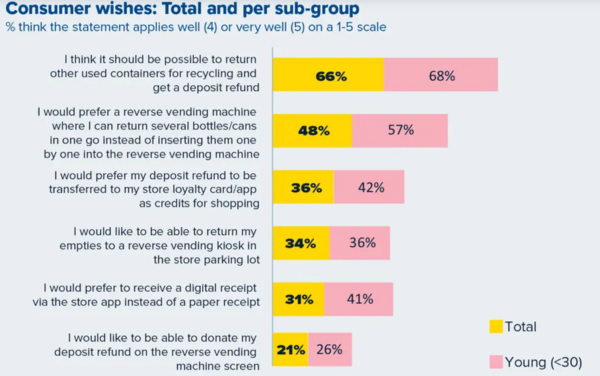However, one country out of the seven, Slovakia, bucked the trend, with youth recyclers putting environment right at the top of the list. Young recyclers in Germany and the Netherlands, on the other hand, placed more emphasis on keeping their homes tidy and put environment in third place.
Store selection and deposit redemption
The TOMRA study went on to explore what influences consumers when they choose a recycling location. The most popular option chosen by the total study population was returning empties to the store where they do most of their grocery shopping (31%), while only 26% use the store closest to home. This was opposite for young recyclers, with the store closest to home their first choice (33%) and a slightly lower 30% preferring their main grocery store.
On reasons generally to choose a shopping location, low prices was the main attractor across the board, and in several countries a clean and well-organized store was highly important. Availability of parking was much less important, with fewer in this age group having access to a car. This age group was also more in favor of self-service checkouts when compared with the whole study group.
"We also wanted to explore ‘recycling loyalty’,” explains Mette Mari Heyerdahl. “We found that 81% of young recyclers put their deposit refund towards grocery purchases at the store where they return their containers, lower than for respondents of all ages (87%). Young recyclers were more likely to redeem the receipt for money without buying in store, with 13% choosing this option.”
Frequency and volume recycling trends
Almost half (46%) of those in the under-30 age bracket return their drink containers 1-2 times per month. Just over a quarter (26%) prefer to do so every other month. 20% opt for once a week, while 8% make several visits per week.
Although young recyclers were found to return their containers less often, it was noted that they return more containers per person than average.
“In six of the seven countries they showed a clear preference for recycling once or twice a month, but Slovakia was the exception,” adds Mette Mari Heyerdahl. “When we look at this data alongside the volume of containers they recycle, we can see Slovakia’s young consumers are split between recycling little and often, or waiting until they have a larger amount of up to 39 containers before they return them.”
Using recycling trends to be competitive
TOMRA believes the results of the study can be extremely useful to retailers who want to drive consumer loyalty and ultimately boost sales.
“This research has provided valuable insights into what recyclers want to see now and in the future. These recycling trends showed us that reliability, convenience, speed and hygiene are key, and retailers should also be mindful of how highly the younger demographic rates digital experiences,” Mette Mari Heyerdahl concludes.
_______________
*Only available in Norway
_______________
www.tomra.com











